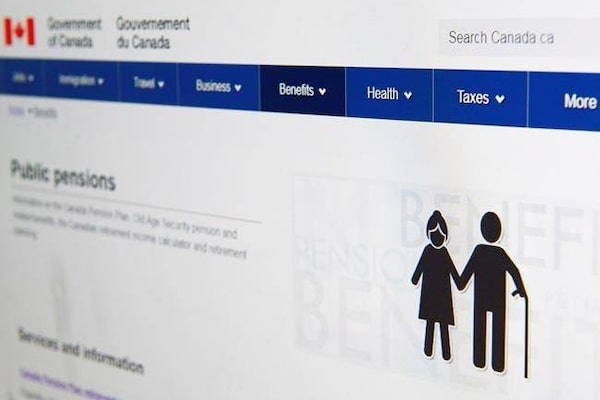
The Government of Canada public pensions web page on Jan. 9, 2018.The Canadian Press
Ottawa is starting to feel the pinch of its fiscal handcuffs this year, as flagging revenue growth and surging debt costs limit the spending propensities – or at least ability – of the Liberals.
But those handcuffs are going to grow much tighter through the rest of this decade. According to new projections in this week’s fall economic statement, just two categories, elderly benefits and debt servicing costs, will account for 52 cents out of every new dollar that the federal government spends in fiscal 2028-29 compared with fiscal 2022-23.
Interest costs are largely beyond Ottawa’s control (other than the elemental step of not making the problem any worse). That is partly true as well for elderly benefits, the government’s inelegant name for Old Age Security and Guaranteed Income Supplement payments, which are set to rise sharply as Canada’s population of retirees steadily increases.
Last year, the federal government spent $69.4-billion on elderly benefits. That will jump to $101.3-billion in fiscal 2029. Debt servicing costs are set to rise to $60.7-billion in fiscal 2029 from $35-billion in fiscal 2023. Together, those two line items will grow by $57.6-billion by the end of the decade.
The government can act now to loosen its handcuffs by paring back payments to high-income seniors. Any such changes should not touch Canada Pension Plan payments: that pension income comes from lifetime contributions and is in any case held separately from Ottawa’s accounts.
But the Old Age Security program is a different animal. It is a pure spending program, not a pension, and paid out of the government’s general revenues, not contributions. Remove age from the equation for a moment, and answer this question: what conceivable reason is there for Ottawa to be sending monthly cheques to households with annual incomes approaching $340,000?
There is no reason, of course, but that is exactly what happens under the current structure of the OAS. Clawbacks of the benefit ($8,492 a year) start when an individual’s taxable income reaches $81,761 but even those making up to $134,626 receive reduced payments, or $137,331 for seniors over 75 whose OAS entitlement is increased by 10 per cent. For individuals who deferred receiving OAS in exchange for higher monthly payments, that ceiling is considerably higher, around $170,000. And those clawbacks are assessed on an individual, not a household. A household made up of two seniors eligible for the maximum OAS could have a combined income of about $340,000 and still receive a small monthly payment from Ottawa.
There is no rationale to pay income support to Canadians who are by any reasonable standard extremely well off. There is no moral case either. The OAS does not flow from contributions. The chief criterion for a full benefit is that a recipient has lived in Canada for at least 40 years of their adult life.
The case for paring back OAS is ironclad. Yet, the Liberals have moved in precisely the opposite direction, starting with the move early in their first term to roll back the Conservative policy of gradually increasing the eligibility age for the full OAS to 67 from 65. That would have substantially reduced the growth in the cost of elderly benefits.
Last year, the Liberals boosted OAS by 10 per cent for seniors 75 years and older, claiming it would help poorer senior citizens. That claim is nonsensical – if the government wished to help poor seniors, it already has a tailor-made program at hand: the Guaranteed Income Supplement. (The income cutoff point is much lower than for the OAS, just $21,456 for individuals.) Any OAS reform should start with scrapping that 10-per-cent increase and targeting those funds narrowly to low-income seniors who receive the GIS.
It’s too late to reverse the misguided decision to halt the planned increased in the retirement age. If gradual, such an increase would take effect only after the number of retirees had begun to decline. If immediate, it would unfairly disrupt the financial plans of imminent retirees.
Instead, the government can increase the clawback rate for the OAS, lowering the cutoff point at which benefits peter out. The starting point for clawbacks should be lowered as well, and the government should consider making that assessment on a household rather than an individual basis.
Any such change is bound to be controversial. But the government and well-off seniors need to realize the fundamental unfairness of ramping up income subsidies to rich households as federal finances become increasingly constricted.